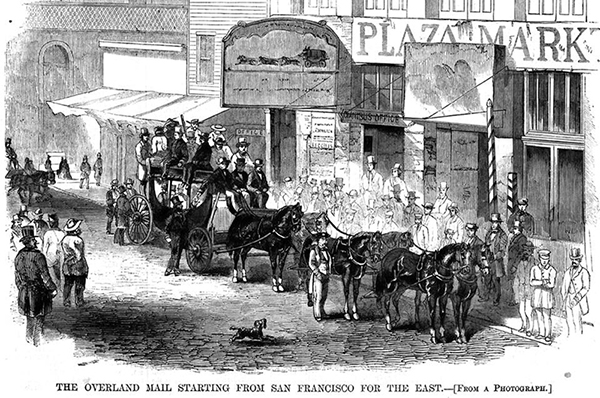
In the 1850s California was rich in resources, but cut off from the rest of the country. For this reason the Butterfield Stage Lines were developed.
In the late 1850s the problem of slavery was becoming a more divisive issue between north and south. It was clear that California, rich in gold and other resources, needed to be brought into communication with the rest of its sister states. A stagecoach line was an option, but Northerners favored a northern route, while southerners naturally campaigned for a southern route. Southerners hoped that a southern route would funnel California riches to them, and help the spread of slavery.
The “Oxbow” Route to California
Since the proposed stagecoach line to California was to carry the U.S. Mail, a clause in an Enabling Act passed by Congress made the Postmaster General the final arbiter on the matter. It just so happened that the then-Postmaster General was a proslavery southerner, Aaron Brown.
Brown naturally opted for a southern route, a long, “U” shaped trail that dipped deeply into Texas, then passed through Arizona. From Tipton, Missouri—near the railroads at St Louis—the route continued to Ft. Smith, Arkansas, then through the Texas towns of Sherman and El Paso, thence to Fort Yuma, Los Angeles, and San Francisco.
Northerners were not happy about the Postmaster’s selection. The Northern press scornfully dubbed the trail the “Oxbow,” “Horseshoe,” or “sideline.” The Chicago Tribune called the plan “the greatest swindle ever perpetrated upon the country by the slaveholders.”
John Butterfield and the Butterfield Stage Line
An expressman named John Butterfield—ironically a New Yorker—was awarded the stagecoach contract. He worked with determination, cutting new roads, purchasing 1,800 head of stock, and securing 250 of the finest coaches money could buy. Concord coaches and celerity wagons were used along the line. Celerity wagons were lightweight vehicles covered by flimsy canvas tops. They didn’t have the romance of their larger “cousins,” but they could go over ground that the heavier Concords could not.
The Concord Coach
But there were stretches that could take heavier wagons, and it was in these locales that the Concord Coach really shined. The Concord Coach—named after a town in New England, where it was made—was the finest product of Yankee ingenuity and nineteenth century technology. A superbly crafted vehicle, it boasted brasswood panels, leather benches, and burnished brass lamps. The entire body of the coach rested on two oxhide strips, which performed as primitive shock absorbers. The Concord became symbol of the west, well known even today because of its adoption as a corporate logo for Wells Fargo Bank.
Travelling the “Oxbow” Line
The Butterfield Stage Line began operations in 1858. The first westbound coach arrived in San Francisco in 23 days, 23 hours—well under the 25 days travel time that was stipulated by Congress. The Butterfield Stages lasted until 1861, a victim of the Civil War. The fare was $200, and only the most adventurous souls took the trip. It was dusty, and dirty, with periods of stifling heat and bone-chilling cold. There were occasional stops at way stations, were the food was bad and the coffee worse.
Yet there was also an opportunity to see the real west—a west that was soon to disappear within the next 25 years. There were vast stretches of unfenced prairie, and huge herds of grazing buffalo. There was also a chance of seeing a Native American Indian. For those who dared the Butterfield route, there was enough adventure to last a lifetime.
Sources:
- Edward S Barnard, ed. Story of the Great American West (NY: Reader’s Digest, 1977)
- David Nevin, The Expressmen (Time-Life, 1980)







